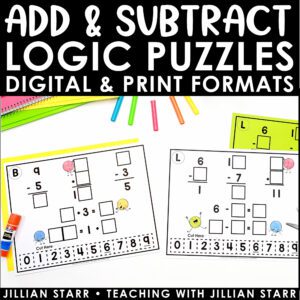
Ready for the next addition strategy to add to your students’ toolbox? This post is all about The Transformation Strategy.
In the previous post on the Compensation Strategy, I talked about the importance of allowing the natural development of these addition strategies. Yes, the pressure to teach and enforce new addition strategies comes at teachers from many directions. And yes, I’ve been there too!
But, students will naturally begin to make connections between numbers as they develop their number sense. Rather than insist they use new strategies, we can guide them.
The Transformation Strategy might not sound familiar immediately. That’s okay! As you read through, you might notice that MANY OF US naturally employ the transformation strategy as we develop proficient number sense and understand the relationships between numbers.
And, even more, you might realize that you’ve been teaching aspects of the transformation strategy but used different names. Ready to dive in?
What is the Transformation Strategy?
“Transformation” in the Transformation Strategy refers to how students transform numbers into easier-to-use integers before adding.

Here’s an example. Let’s say the problem is 298+23. Students might see that 298 is just two less than 300 and transform it into 300. Then, they would need to take away two from 23. They are ultimately transforming the problem to 300+21.
Students can get the correct answer by making minor adjustments.
The Transformation Strategy vs. The Compensation Strategy
The transformation strategy and the compensation strategy are both used when we see a number that is just begging to be rounded up or down (like 298 in the problem above).
However, the transformation strategy has us adjusting both numbers at the same time, and BEFORE we begin solving for the answer.
Take a look at the following problem: 197+254. Let’s see how we would solve the problem, first with the compensation strategy, and then with the transformation strategy.

Do you see how the numbers are adjusted in the compensation strategy in two different steps, but in the transformation strategy they are adjusted simultaneously? It may seem like a small difference, but it is still a different strategy and generalizes to other operations and concepts differently.
What Does the Transformation Strategy Look Like in First Grade?
What do you call this process?
8+5 becomes 10+3
In first grade, many teachers already teach this strategy as “make a ten to add” or “bridges to ten.” When students notice that one of their addends is close to ten, they:
- Identify how far away that addend is from ten.
- Extract that amount from the other addend to make the first addend ten.
- Add the two new numbers with much more ease.

This process helps our students think about addition problems in relation to ten. If our students see the equation 9+3, this strategy helps them shift their equation to 10+2.
What Does the Transformation Strategy Look Like in 2nd Grade?
The beauty of the transformation strategy: it continues to work as students grow.
In second grade, students begin working with larger numbers, including two-digit numbers. Students get to start noticing a variety of benchmark numbers in their work. For example:
- 29+6 (29 is one away from 30)
- 58+15 (58 is two away from 60)
- 63+39 (39 is one away from 40)
For 29+6, a student might use what they learned about “Make a Ten to Add” in first grade and see that they can shift the “9+6” from 29+6 to 10+5. They can then extend that thinking to transform 29+6 to 30+5.

When a student is working to solve 29+56, they can follow the same pattern of thinking. 29 is very close to a multiple of ten, so transforming the problem to 30+55 will make it much easier to solve!
Students may also start to see additional number relationships outside of multiples of ten. For example, I had a student approach 73+27 with the transformation strategy. They saw that both numbers were only two away from multiples of 25.

They had been working with quarters in our money unit, and they knew that 75¢ and 25¢ together made $1.00. Therefore they transformed 73+27 into 75+25 to create an easier problem for them to solve. BRILLIANT!
What does the Transformation Strategy Look Like in 3rd Grade?
When working with larger numbers, it can take more effort and working memory to hold onto the transformations in our heads. However, if we really allow students to hone in on the relationship between numbers, they will still find this strategy handy as they get into 3 and 4-digit addition.
For example, a student might encounter the problem: 2997+3685.

The student may choose to add 3 to 2997 in order to work with a friendlier number like 3000. At the same time, they will take away 3 from 3685 to get 3682. Now they are free to solve a more mental-math-friendly problem, 3000+3682.
Closing Thoughts on Transformation
We want students to notice the relationships between numbers that naturally lead them to use the transformation strategies. In an ideal world, our gentle guidance and direction around number relationships will do just that.
So what do we teach explicitly? When we see students using this strategy, we can highlight it! Have them explain their reasoning with a peer or in a larger group. We can explicitly discuss why this is an efficient strategy for this particular problem.
Even with the demands of our curriculums, we can help develop these strategies organically when we allow students to learn from each other.
It is exciting to watch students as they develop number sense and add these addition tools to their mental toolboxes. As you notice students using the transformation strategy organically, you can now name it! No matter the grade!










